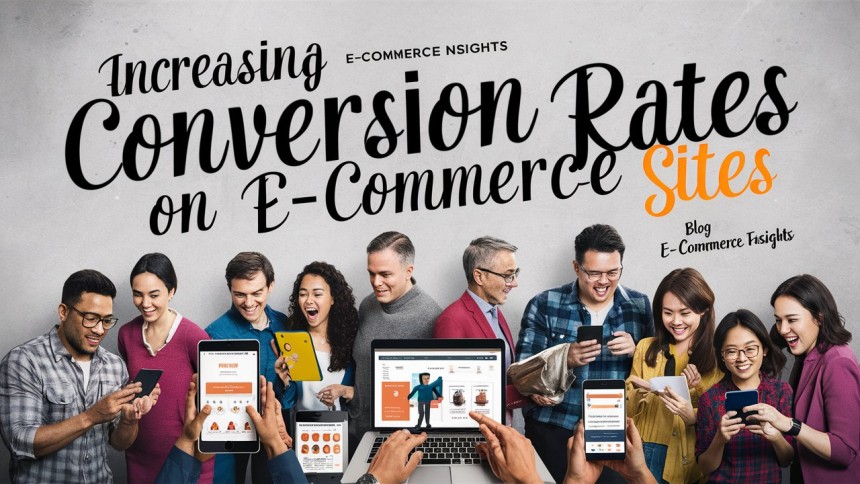
Increasing Conversion Rates on E-commerce Sites
Learn proven strategies to increase conversion rates on your e-commerce site and turn visitors into loyal customers.
Conversion rates measure the percentage of site visitors who make a purchase, and improving them is essential for any e-commerce business. The average e-commerce conversion rate typically sits around 2.5-3%, with top-performing sites achieving as high as 20%. Increasing these rates is achievable with targeted strategies that cater to user experience, trust-building, and smart digital practices.
1. Optimize Product PagesProduct pages are the backbone of an e-commerce site. A well-optimized page should not only describe the product but also instill confidence in potential buyers.
- High-Quality Media: Use clear, high-resolution images and videos from multiple angles to show customers exactly what they’re getting.
- Detailed Descriptions: Focus on benefits rather than just features. How does the product solve a problem or improve the buyer’s life?
- Customer Reviews: Showcase authentic reviews, as feedback from other buyers can significantly influence purchasing decisions.
- Transparent Pricing: Display prices and any discounts. No one likes surprises at checkout, so transparency here is crucial.
Good navigation acts as a guide, helping visitors find products quickly and easily. Ensuring a smooth browsing experience reduces frustration and keeps users on your site longer.
- Advanced Search Options: Implement features like autocomplete and typo tolerance, so customers can find what they’re looking for even if they don’t know the exact name.
- Logical Menu Structures: Organize your site intuitively, so visitors can navigate between categories without confusion.
- Breadcrumb Navigation: Help users retrace their steps with breadcrumb links, which enhance the browsing experience and encourage further exploration.
Cart abandonment is often a result of complicated checkout processes. Streamlining this step can make a significant impact on conversion rates.
- Guest Checkout: Allow visitors to purchase without signing up for an account, reducing friction and saving time.
- Fewer Form Fields: Only request essential information to make checkout faster.
- Multiple Payment Options: Cater to diverse preferences by offering different payment methods.
- Security Badges: Display secure payment badges to reassure users about the safety of their data.
People are more likely to buy if they see that others have had a positive experience with a product. Social proof is a powerful way to establish trust and credibility.
- Customer Testimonials: Feature authentic testimonials prominently on product pages.
- Trust Badges and Certifications: Use certifications like “Verified Purchase” to reassure potential buyers.
- Social Media Integration: Showcase trending products or user-generated content to build a sense of popularity and authenticity.
Personalization helps customers feel understood, making them more likely to engage and buy.
- Product Recommendations: Use past browsing or purchase data to suggest related products.
- Custom Content and Offers: Tailor promotions based on location, purchase history, or browsing behavior.
- Dynamic Pricing: Implement variable pricing based on factors like demand or browsing patterns, creating a more customized experience.
A large portion of online traffic comes from mobile users, making mobile optimization crucial for conversion rates.
- Responsive Design: Ensure your site is compatible with different devices and screen sizes.
- Fast Loading Times: Mobile users expect quick loading times, so aim for optimized images and streamlined code.
- Mobile-Specific Features: Features like one-touch payments and simplified navigation enhance the experience for mobile shoppers.
Urgency and scarcity can prompt action, making customers less likely to delay their purchase decision.
- Limited-Time Offers: Highlight time-sensitive deals with countdown timers.
- Low Stock Notifications: Show low stock alerts for popular items.
- Flash Sales: Run occasional flash sales to create excitement and spur quick action.
Shipping and returns policies are often deciding factors for online shoppers. Making these customer-friendly can encourage more conversions.
- Free Shipping Options: If feasible, offer free shipping or set clear minimums to qualify for it.
- Generous Return Policies: A hassle-free return policy reduces perceived risks for buyers.
- BOPIS (Buy Online, Pick Up In-Store): For businesses with physical locations, offer in-store pickup to attract local shoppers.
Email is a valuable tool to retain potential customers and keep them engaged with your brand.
- Abandoned Cart Reminders: Send reminders to visitors who left items in their cart, sometimes including a discount.
- Personalized Campaigns: Target email content based on customer behavior, such as recent browsing or purchase history.
- Exclusive Offers: Reward email subscribers with exclusive deals to encourage loyalty.
A/B testing helps you understand what works best for your site’s visitors. Continuous testing and optimization allow for data-driven improvements.
- Experiment with Layouts: Test various layouts and page designs to see which performs best.
- Optimize CTAs: Try different call-to-action phrases and button colors to find the most effective combinations.
- Analyze Results: Use insights from tests to make continuous, incremental improvements to your site.
A digital marketing agency in Pakistan can play a key role in helping e-commerce businesses implement and refine these strategies. With expertise in user experience design, data analysis, and content optimization, these agencies provide actionable insights that can elevate your website’s conversion rates. By employing effective strategies tailored to your specific market, a digital marketing agency can support your business in achieving a significant increase in sales.
ConclusionIncreasing conversion rates on e-commerce sites requires a balanced approach that addresses user experience, trust, and personalization. From optimizing product pages and improving site navigation to enhancing the checkout process and leveraging social proof, each step contributes to a seamless shopping experience that drives conversions. Remember that successful strategies often require ongoing testing and refinement to stay aligned with evolving customer expectations and market trends.
Improving conversion rates is not just about attracting visitors; it’s about making every interaction count. By consistently optimizing each element of the e-commerce journey, businesses can boost conversions and build a more loyal customer base.


